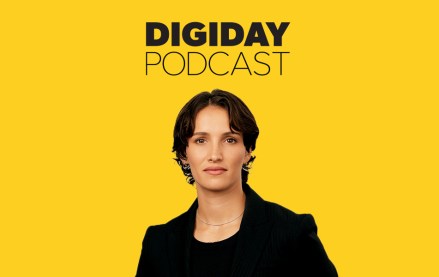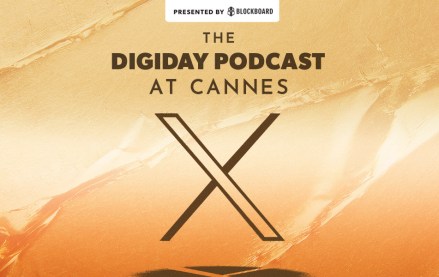How creators Molly Burke and Tyler Oakley grew online communities through advocacy

This article is part of a special Digiday Podcast series that covers how content creators are building their brands and earning revenue from various major social media platforms. More from the series →
Subscribe: Apple Podcasts • Spotify
Molly Burke and Tyler Oakley joined YouTube more than a decade ago and built their respective online followings by advocating for the causes and communities of people that were important to them — even if it wasn’t always the easiest way to rapidly grow given the platform’s algorithm.
Since then, Burke and Oakley both expanded to additional platforms, like Patreon and Twitch, to continue garnering meaningful relationships with their followers. While Burke said she’s been able to learn a lot about her viewers personally through Patreon, Oakley said that two-way direct communication on Twitch has been instrumental in how he creates content in the moment.
In the fourth and final episode of the Digiday Podcast’s Creators series, Burke and Oakley discuss why advocacy and speaking from the heart has always been central to their strategies as long-form video content creators, and why that’s helped grow their audiences and businesses.
Below are highlights from the conversation, which have been lightly edited and condensed for clarity.
Advocacy vs. the algorithm
Burke: It was hard for me to grow at first because, while there is a thriving community of disabled content creators on social media now, when I began, there wasn’t. There was a huge beauty community and fitness community and travel community and gaming community, but there was not a disability community … It was really hard to get into the algorithm, because especially back then, everything on YouTube was about getting into that homepage recommended section. But if nobody’s posting content about disability, then nobody’s searching for it, nobody’s watching it … It was a vicious cycle.
And then I remember during the adpocalypse, [instances in 2017 and 2019 where YouTube was aggressively demonizing videos it deemed problematic] my videos would get demonetized if I had the word ‘blind’ or ‘disabled’ in the title or the tags. So there [were] a lot of roadblocks just simply because I’m disabled … Thankfully these platforms [have] progressed a lot since then and these were temporary issues. But these are issues that disabled people face in mainstream marketing in mainstream entertainment. That’s why so many of us have turned to social media to gain a voice and to gain a platform and to gain exposure, because traditional entertainment has left us out.
Oakley: I understand when creators have reservations about not wanting to upset their audience, or say the wrong thing, or support the wrong thing, or whatever. But … I have to speak up for what I need to speak up for … And I have found that so many people appreciate having those open dialogues and conversations because it’s jarring when a creator doesn’t.
It’s not like you have to completely throw away all the fun you’re having. You’re allowed to be exactly the creator you are, but I just believe in standing for what you believe in and leading by example.
[Speaking up for important causes] might cost me, but it won’t cost me my soul.
Building a community
Burke: The same way that followers crave connection with their favorite creators, I think we as creators also crave that connection with our followers, because it allows us to learn and understand who’s watching us and why they’re watching us better … I know about them, I know about their lives … I can’t do that on platforms where I have hundreds of thousands or millions of people following me the way that I can on Patreon, where it’s a small group of really dedicated passionate people.
Oakley: I’ve been on every platform, and I have never experienced the level of engagement and honest interaction with intention than on Twitch.
Advertiser appetite for short-form video
Burke: In my case with direct brand deals, absolutely [the] majority [are for] short form [videos] and has been for, I’d say, at least three years now, which was something I did not expect when I started creating short form and 2020. I was posting eight videos a week on my YouTube channel — long form videos — and at one point, I would have to say no to sponsors because otherwise every single video would be sponsored. Whereas now, I’ll maybe have one or two sponsored videos in the month on YouTube and the majority of the income is coming from short form sponsorships.
YouTuber to Twitch streamer
Oakley: [Twitch] feels more like improv as opposed to skit performance [for YouTube] … The atmosphere of live collaboration on Twitch actually so benefits my brain … If the audience chat is feeling feral in a direction that is chaotic and silly, I am not going to say no to that … Whereas if I were sitting down and filming a YouTube video, there’s no outside influences that could shift what I want to create.
Ultimately, I kind of have to surrender myself to: “what are we co-creating today?” And trusting that I’ve cultivated an audience that understands the vibe I like to establish, but also will push me to maybe go outside my comfort zone a little bit and try something new or play in a different direction.
More in Podcasts

How TikTok’s ‘The Secret Lives of Mormon Wives’ landed on Hulu, with Select Management Group’s Danielle Pistotnik
The talent manager and executive producer of “The Secret Lives of Mormon Wives” joined the Digiday Podcast to break down the process of the reality show finding a home on Hulu.

Digiday Podcast at Cannes: Former Bachelorette Rachel Lindsay makes the case for creators
Between panels and parties, creators are looking to get face time with ad execs, brand marketers and partners like Spotify. However, rather than coming to the Croisette to strike deals, they’re playing a long game.

Digiday Podcast at Cannes: From center stage to closed doors, inside X’s quiet Cannes strategy
Once a Cannes hotspot, Twitter Beach is no more. In this episode, we explore X’s quiet retreat from the Croisette—and why no one’s talking about the TikTok ban either.






